Originally published on allaboutgranite.wordpress.com (previous blog) on the 18th May 2017.
I was out of the office on fieldwork earlier this week looking at granite textures with researchers from the University of Western Australia and University of Bristol. We only visited two beaches, both within a short walk of each other at Cape Cornwall, but these two beaches have a spectacular array of granite types and textures. It wasn’t the greatest weather, but ideal for seeing some of the textures!
Granite variation
The granites at Priest’s Cove and Porth Ledden have either biotite group minerals or tourmaline as the dominant ferromagnesian mineral and can therefore be imaginatively named “biotite” or “tourmaline” granites [e.g. 1,2,3]. However, there is considerable textural variation, with fine- to coarse-grained biotite and tourmaline granites, with and without alkali feldspar phenocrysts. One class of tourmaline granite also comprises rounded, “globular” quartz. Contacts are lobate, sharp and cryptic so it’s a good place to see in situ granite variation, including magma mingling between the different granite lithologies. It’s also a great place to look at zoning in alkali feldspar phenocrysts which is visible without a thin section, as are the radial inclusions within the phenocrysts.
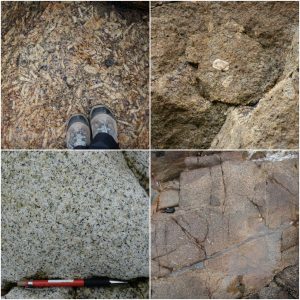
Pegmatites and aplites
Within the granites, particularly at Priest’s Cove, there are pegmatitic “pods” comprising euhedral, lath-shaped tourmaline and quartz, with and without alkali feldspar. Pegmatite dykes and sheets also crosscut the foreshore, with stockscheider feldspars (also called unidirectional solidification textures, USTs) at the country rock dyke margins and within the dykes themselves, as evidence for multiple phases of melt emplacement. These pegmatites didn’t cool slowly over millions of years, but formed rapidly due to sudden changes in pressure. The UST feldspars are elongate, and crystals like this commonly form when there is rapid, pressure change-driven cooling, with high crystal growth rates and fewer nucleation (growth) sites (e.g. [4]).
Aplites, which are fine-grained rocks dominated by quartz and feldspar with minimal ferromagnesian components, form discrete veins, sheets and dykes both within the granites and host country rocks. Contacts are sharp, and sometimes delineated by bands of tourmaline and / or mica. Within aplite sheets, line-rock may form, with variable bands of pegmatite aplite, granite, tourmaline, mica and feldspar. This is likely linked to oscillatory nucleation and crystallisation of different minerals, again driven by pressure changes within the sheets.
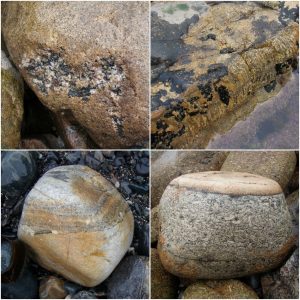
Xenoliths and enclaves
Country rock xenoliths plus non-igneous and mafic microgranular enclaves (MME) can all be seen in the granites at Porth Ledden. In common with the majority of the other Cornubian granites, xenoliths of the older host country rocks are entrained within the granites. These frequently retain their original sedimentary structures, including bedding and cleavage(s) and display sharp and altered contacts. Smaller, partially disaggregated non-igneous enclaves comprise biotite, muscovite, cordierite, quartz and feldspars with corundum, sillimanite and zircon. These may represent crustal material from the source zone of the granites, material left after source melting (restite) or country rock from greater depths than currently exposed [5].
Mafic microgranular enclaves are rounded, fine-grained, with and without alkali feldspar megacrysts. These enclaves vary in size and are found in both biotite and tourmaline granites at Priest’s Cove and Porth Ledden. They typically comprise biotite, calcic plagioclase and minor ilmenite and quartz, interpreted to represent mixing between granite and mafic magmas [5].
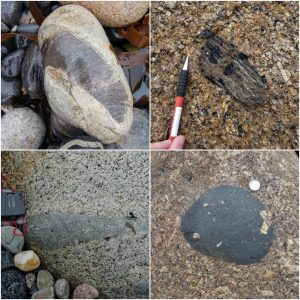
So much boron…
On both beaches, the biotite granites contain quartz-tourmaline “orbicules” and at Porth Ledden, there are wide (10s of metres) zones of massive quartz tourmaline (MQT) rock occurring in the apical parts of the granite. The MQT consists mainly of quartz and tourmaline (hence MQT), with minor topaz and apatite. The origin of the orbicules and MQT is debatable, with some authors arguing for a magmatic origin, through unmixing (separation) of a boron-silica-rich melt from a granitic melt [e.g. 6,7]. However, others believe the MQT forms as metasomatic replacement of a granite by a boron-rich fluid front and the orbicules have a similar fluid-dominated origin [e.g. 8]. Whatever the interpretation, there’s an awful lot of boron required to make a rock with ~50% tourmaline.
At Porth Ledden, the MQT show variation from a more quartz-dominated rock to a tourmaline-dominated rock nearing the contact with the country rocks. This is likely because iron and magnesium are required to crystallise tourmaline, and an evolved granite melt may not contain significant abundances of these elements. Closer to the country rock, these elements can be scavenged to start forming tourmaline. There’s also an even more bizarre variant, a tourmaline-apatite rock, which has a limited exposure and forms massive pods and veins of material. Not sure anyone has figured that out, but along with boron, there’s also a lot of phosphorus in these granites, certainly enough to make apatite.
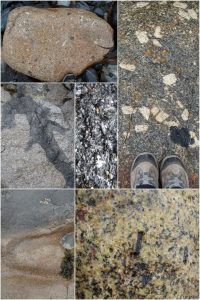
Just a note, no granites were harmed in the making of this post! No hammering allowed if you visit these locations, they’re special because of their geology and protected as SSSIs 🙂

References
[1] Manning et al. (1996) Journal of the Geological Society: 153.
[2] Simons et al. (2016) Lithos: 260.
[3] Simons et al. (2017) Lithos: 278-281.
[4] Webber et al. (1999) American Mineralogist: 84.
[5] Stimac et al. (1995) Mineralogical Magazine: 59.
[6] Müller et al. (2006) Ore Geology Reviews: 28.
[7] Drivenes et al. (2015) Contributions to Mineralogy and Petrology: 169.
[8] Rozendaal and Bruwer (1995) Journal of African Earth Sciences: 21.
